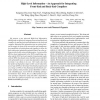21 search results - page 3 / 5 » Constraint Integer Programming: A New Approach to Integrate ... |
INFORMS
1998
13 years 4 months ago
1998
constraint abstractions into integer programming, and to discuss possible combinations of the two approaches. Combinatorial problems are ubiquitous in many real world applications ...
CP
2003
Springer
13 years 10 months ago
2003
Springer
Abstract. The Quasigroup Completion Problem (QCP) is a very challenging benchmark among combinatorial problems, and the focus of much recent interest in the area of constraint prog...
CP
2005
Springer
13 years 10 months ago
2005
Springer
Abstract. In an increasing number of domains such as bioinformatics, combinatorial graph problems arise. We propose a novel way to solve these problems, mainly those that can be tr...
ICPP
1998
IEEE
13 years 9 months ago
1998
IEEE
We propose a new universal High-Level Information (HLI) format to effectively integrate front-end and back-end compilers by passing front-end information to the back-end compiler....
CP
2003
Springer
13 years 10 months ago
2003
Springer
Multiple sequence alignment is a central problem in Bioinformatics. A known integer programming approach is to apply branch-and-cut to exponentially large graph-theoretic models. T...

